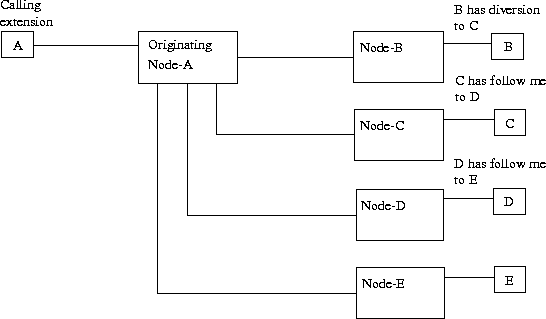Chaining of Network Diversion
A diverted-to position for diversion, but not message diversion, may be diverted with follow me. A diverted-to position may also be diverted with diversion on no reply, but only if the previous diversion reason is direct diversion or follow me. All other repeated diversions are blocked.
For network diversion there is a counter, set by the diversion_system command, stating the maximum number of chained network diversions that is allowed for one call. This counter is placed in the originating node and is increased each time a new diversion call set up is done.
The following figure 20 shows a possible DPNSS or homogeneous ISDN/H.323 network configuration, where the maximum number of repeated diversions is set to 2 in the originating PBX-A by command:
diversion_system -c--div-network-chaining 2 --div-no-reply-first 15\ --div-no-reply-second 5 --div-type-priority 1

Extension A calls extension B. Extension B has activated diversion (that is, any of busy, direct diversion, or no answer diversion) to extension C. Node-A receives the C identity from Node-B and proceeds by increasing the diversion counter to one before a new call set up is done to extension C. Extension C has activated follow me to extension D. Node-A receives the D identity from Node-C and proceeds by increasing the diversion counter to two before a new call set up is done to extension D. Extension D has activated follow me to extension E. Node-A receives the E identity from Node-D and proceeds by increasing the diversion counter to three. But only two chainings are allowed.
Depending on the state of extension B, the following will happen:
If extension B has activated direct diversion or follow me, a no-progress tone is sent to extension A. If extension B has activated diversion on busy, a busy tone is sent to extension A. If extension B has activated diversion on no answer it will keep on ringing on extension B.